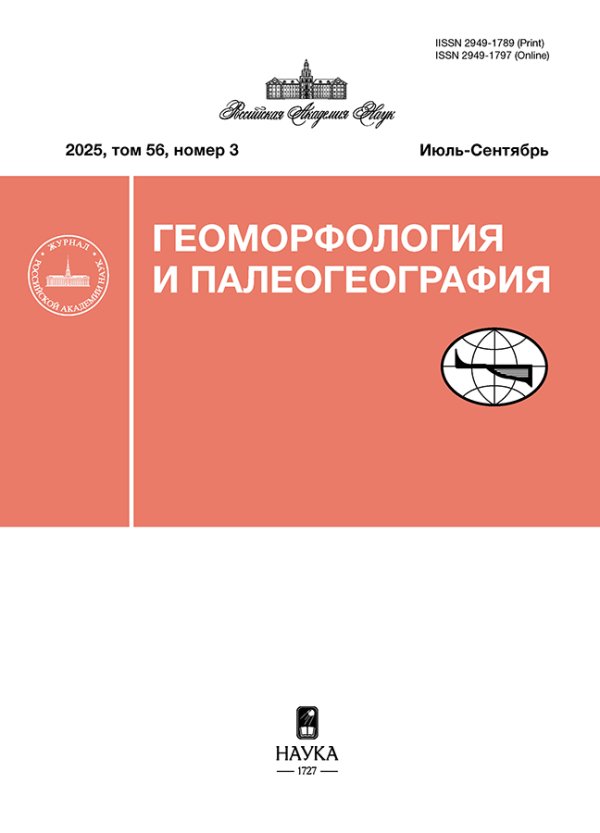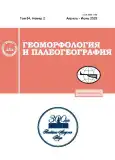EXPERIMENTAL ESTIMATE OF EROSION MECHANISM AT THE EARLY STAGE OF GULLY FORMATION1
- Authors: Larionov G.A.1, Krasnov S.F.1, Litvin L.F.1, Gorobets A.V.1, Kobylchenko (Kuksina) L.V.1, Kriuchkov N.R.2
-
Affiliations:
- Lomonosov Moscow State University, Faculty of Geography
- Lomonosov Moscow State University, Soil Science Faculty
- Issue: Vol 54, No 2 (2023)
- Pages: 97-104
- Section: SHORT COMMUNICATIONS
- URL: https://journals.rcsi.science/2949-1789/article/view/139469
- DOI: https://doi.org/10.31857/S2949178923010085
- EDN: https://elibrary.ru/GQFSMY
- ID: 139469
Cite item
Full Text
Abstract
The article presents results of experiment and its theoretical justification aimed to study the mechanism and intensity of the early stage of gully head formation. The experiment was carried out using the jet installation that allows to change the angle of the water stream from 0.5 to 90° with the flow velocity of up to 6 m/s. The flow angle was changed with a 10° step, while the flow velocity was maintained in the range of 1.01–1.04 m/s. The intensity of soil erosion positively correlates with the flow angles (angles of attack) in the range from zero up to 40°. When the angle was increased to 50–90°, the intensity continuously declined. The lowest absolute values of erosion intensity were observed when the water flow was normal to the soil surface. There are two main reasons why the intensity of soil erosion changes with changing angle of stream flow; the first is hydraulic, the second is hydro-mechanical. The former determines weakening and destruction of inter-aggregate bonds by the water penetrating into the soil; the latter – by the combined vectors of forces of hydrodynamic head and forces keeping the particle (aggregate) in place. The experiment showed that the maximum impact of water jet on a separate soil particle occur at angle of 41°. The flow in a gully happens occasionally and the results obtained should be attributed to the early stage of erosion: the stage before formation of a so called gully headcut.
About the authors
G. A. Larionov
Lomonosov Moscow State University, Faculty of Geography
Email: GorobetsAV@geogr.msu.ru
Russia, Moscow
S. F. Krasnov
Lomonosov Moscow State University, Faculty of Geography
Email: GorobetsAV@geogr.msu.ru
Russia, Moscow
L. F. Litvin
Lomonosov Moscow State University, Faculty of Geography
Email: GorobetsAV@geogr.msu.ru
Russia, Moscow
A. V. Gorobets
Lomonosov Moscow State University, Faculty of Geography
Author for correspondence.
Email: GorobetsAV@geogr.msu.ru
Russia, Moscow
L. V. Kobylchenko (Kuksina)
Lomonosov Moscow State University, Faculty of Geography
Email: GorobetsAV@geogr.msu.ru
Russia, Moscow
N. R. Kriuchkov
Lomonosov Moscow State University, Soil Science Faculty
Email: GorobetsAV@geogr.msu.ru
Russia, Moscow
References
- Armand D.L. Revue of experimental methods in geomorphology. Problemy fizicheskoi geografii. Vol. XIII. Moscow–Leningrad: AN SSSR (Publ.), 1948. P. 37–58. (in Russ.)
- Bastrakov G.V. (1994). Erozionnaya ustoichivostʼ relʼefa i protivoerozionnaya zashchita zemelʼ (Erosion resistance of relief and anti-erosion protection of land. Bryansk: Izd-vo BGPI (Publ.), 260 p. (in Russ.)
- Courivaud J.-R., Fry J.-J., Bonelli S. et al. (2009). Measuring the erodibility of soil materials constituting earth embankments: a key input for dams and levees safety assessment. Hydro. 9 p.
- Dabney S.M., Shields F.D.-Jr., Temple D.M., Langendoen E.J. (2004). Erosion processes in gullies modified by establishing grass hedges. Transactions of the ASAE. Vol. 47. No. 5. P. 1561–1571.
- Hanson G.J., Cook K.R. (2004). Apparatus, test procedures, and analytical methods to measure soil erodibility in situ. Applied Engineering in Agriculture. American Society of Agricultural Engineers. Vol. 20. No. 4. P. 455–462. https://doi.org/10.13031/2013.16492
- Khalifa M.A., Zahra Kh.A. (2014). Collective Review in Particular Reference to Soil Erosion around Maritime Structures, Effects of the Angle of Wave: Attack on Coastal Areas Formation and Variation on Transport Rates. American Journal of Marine Science. Vol. 2. No. 1. P. 25–32. https://doi.org/10.12691/marine-2-1-4
- Kimiaghalam N., Clark S.P., Ahmari H. (2016). An experimental study on the effects of physical, mechanical, and electrochemical properties of natural cohesive soils on critical shear stress and erosion rate. International Journal of Sediment Research. Vol. 31. P. 1–15. http://dx.doi.org/10.1016/j.ijsrc.2015.01.001
- Kosov B.F., Nikol’skaya I.I. (1974). Experimental studies of the gully development process. Geomorfologiya. No. 3. P. 39–45. (in Russ.) https://doi.org/10.15356/0435-4281-1974-3-39-45
- Kuznetsov M.S. (1981). Protivoerozionnaya stoikostʼ pochv (Erosion resistance of soils). Moscow: MGU (Publ.), 1981. 135 p. (in Russ.)
- Larionov G.A., Bushueva O.G., Dobrovol’skaya N.G. et al. (2011). Erodibility of model soils with different densities. Eurasian Soil Science. Vol. 44. No. 8. P. 914–918. https://doi.org/10.1134/S1064229311040065
- Larionov G.A., Bushueva O.G., Dobrovol’skaya N.G. et al. (2014). Effect of the water temperature and soil moisture on the erodibility of chernozem samples: a model experiment. Eurasian Soil Science. Vol. 47. No. 7. P. 734–739. https://doi.org/10.1134/S1064229314070096
- Larionov G.A., Bushueva O.G., Dobrovol’skaya N.G. et al. (2016). Assessing the contribution of nonhydraulic forces to the destruction of bonds between soil particles during water erosion. Eurasian Soil Science. Vol. 49. No. 5. P. 546–550. https://doi.org/10.1134/S1064229316050100
- Larionov G.A., Bushueva O.G., Gorobets A.V., et al. (2018). Effect of impact angle on the erosion rate of coherent granular soil, with a chernozemic soil as an example. Eurasian Soil Science. Vol. 51. No. 2. P. 251–254. https://doi.org/10.1134/S1064229318020072
- Larionov G.A., Dobrovol’skaya N.G., Kiryukhina Z.P., Litvin L.F. (2008). Effect of suspended sediments on soil erodibility. Eurasian Soil Science. Vol. 41. No. 7. P. 768–773. https://doi.org/10.1134/S1064229308070119
- Larionov G.A., Litvin L.F., Krasnov S.F. et al. (2016). Experimental research of the cliffs and banks washaway. Geomorfologiya. No. 2. P. 51–58. (in Russ.). https://doi.org/10.15356/0435-4281-2016-2-51-58
- Makkaveev N.I. (1955). Ruslo reki i eroziya v ee basseine (River channel and erosion in its basin). Moscow: AN SSSR (Publ.), 346 p. (in Russ.)
- Makkaveev N.I., Khmeleva N.V., Zaitov I.R., Lebedeva N.V. (1961). Eksperimental’naya geomorfologiya (Experimental geomorphology). Moscow: Izd-vo Mosk. un-ta (Publ.), 194 p. (in Russ.)
- Mirtskhulava Ts.E. (1970). Inzhenernye metody rascheta i prognoza vodnoi erozii (Engineering methods of calculation and prediction of water erosion). Moscow: Kolos (Publ.), 240 p. (in Russ.)
- Nearing M.A., Bradford J.M., Parker S.C. (1991). Soil Detachment by Shallow Flow at Low Slopes. Soil Science Society of America Journal. Vol. 55. No. 2. P. 339–344. https://doi.org/10.2136/sssaj1991.03615995005500020006x
- Nearing M.A., West L.T., Brown L.C. (1988). A Consolidation Model for Estimating Changes in Rill Erodibility. Transactions of the ASAE. Vol. 31. No. 3. P. 696–700. https://doi.org/10.13031/2013.30769
- Osipov V.I. (2014). Physicochemical Theory of Effective Stresses in Soils. Water Resources. Vol. 41. No. 7. P. 801–818. https://doi.org/10.1134/S0097807814070094
- Zolotov A.I. (2005). Assessment of Erosion Resistance of Arable Lands of the Ul’yanovsk Pre-Volga Region for the Purpose of their Anti-erosion Use. XX plenarnoe mezhvuzovskoe koordinatsionnoe soveshchanie po probleme erozionnykh, ruslovykh i ust’evykh protsessov (Ul’yanovsk, 13–15 oktyabrya 2005 g.). Doklady i kratkie soobshcheniya. Ul’yanovsk: UGPU (Publ.), P. 40–44. (in Russ.)
- Zorina E.F. (Ed.). (2006). Geografiya ovrazhnoi erozii (Geography of gully erosion). Moscow: Izd-vo MGU (Publ.), 324 p. (in Russ.)
Supplementary files














